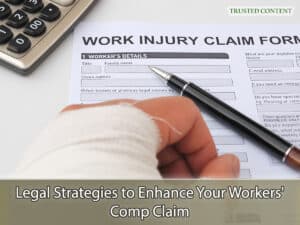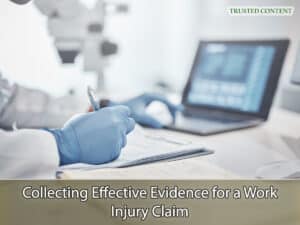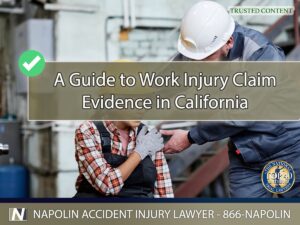A Guide to Work Injury Claim Evidence in Riverside, California

Navigating the complex terrain of workers’ compensation in California requires a deep understanding of both the legal framework and the types of evidence crucial for substantiating work injury claims. This guide offers a comprehensive overview tailored for those seeking to secure their rights and benefits after a workplace injury in southern California.
Overview of California Workers' Compensation
California’s workers' compensation system is designed as a no-fault system intended to quickly provide medical treatment, wage replacement, and rehabilitation services to injured workers. This system ensures that employees injured on the job receive benefits, regardless of who was at fault, making the process simpler and preventing lengthy litigation. Here are key features of the system:
- The no-fault nature means workers do not need to prove their employer was at fault to receive benefits.
- It provides various benefits including medical care, temporary disability benefits, permanent disability benefits, supplemental job displacement benefits, and a return-to-work supplement program.
- Employers are required by law to carry workers' compensation insurance to cover these potential claims.

Legal Strategies to Enhance Your Workers' Comp Claim
Legal Strategies to Enhance Your Workers' Comp Claim
The involvement of skilled legal representation can significantly enhance the robustness and success of a workers’ compensation claim. Experienced attorneys can guide injured workers through the complexities of claim filing and evidence collection. They play a critical role in ensuring that all necessary documentation is correctly prepared and submitted, and can advocate on behalf of the claimant during disputes or appeals, significantly increasing the likelihood of a favorable outcome.
Collecting Effective Evidence for a Work Injury Claim
Gathering the right evidence is paramount in substantiating a workers' compensation claim. Effective evidence not only supports the details of the incident but also establishes the extent of the injuries sustained. Types of essential evidence include:

Collecting Effective Evidence for a Work Injury Claim
Employment Documentation
Accurate and detailed employment records play a crucial role in workers' compensation claims. They provide a clear context of the work environment and circumstances surrounding the injury. Essential documents include:
- Time cards and pay stubs to confirm employment and hours worked
- Accident reports filed with the employer
- Documentation of employer safety protocols and the employee’s adherence to these protocols
Medical Records as Foundation
Comprehensive medical records are critical in demonstrating the nature and extent of injuries related to the work accident. These should include:
- Initial medical reports following the injury
- Detailed records of ongoing treatment
- Assessments by specialists if applicable
- Documentation from physical therapy or rehabilitation
Financial Evidence
Proving economic losses is an integral part of a workers’ compensation claim. Detailed financial documentation helps establish the financial impact of the injury on the worker's life. This includes:
- Detailed bills and receipts related to medical treatments
- Records of lost wages if the injury has led to temporary or permanent disability
- Any additional out-of-pocket expenses incurred due to the injury
By meticulously collecting and organizing these types of evidence, claimants can strengthen their case and enhance their chances of receiving appropriate compensation. Each piece of evidence serves to build a comprehensive picture of the incident and its aftermath, laying a solid foundation for the claims process.
Navigating the No-Fault California Workers' Comp System
California's workers' compensation system is designed as a no-fault scheme, meaning that employees do not need to prove their employer's negligence to receive benefits. This setup is intended to simplify and expedite the process of securing medical treatment, disability payments, and rehabilitation services. Workers benefit from straightforward access to support, while employers are shielded from costly lawsuits except in cases of egregious misconduct.
Understanding No-Fault Compensation
- Automatic Eligibility: Employees are automatically entitled to benefits for injuries sustained in the course of employment, irrespective of fault.
- Broad Coverage: The system covers all necessary medical expenses, a portion of lost wages, and rehabilitation costs.
- Limited Right to Sue: In return for these guaranteed benefits, employees generally forfeit the right to sue their employers for injury-related damages.
Overcoming Common Legal Challenges in Work Injury Claims
Despite the streamlined nature of the no-fault system, claimants often encounter several challenges that can complicate their pursuit of fair compensation. Understanding these potential hurdles can prepare workers to deal with them more effectively.
Challenges and Solutions
- Denials Based on Non-Work-Related Injuries: Employers or insurers might deny claims by arguing the injury did not occur at work. Having robust evidence like incident reports and witness statements is crucial.
- Disputes Over Injury Severity: Insurers may minimize the impact of an injury to reduce payouts. Detailed medical records and expert testimony can counteract this tactic.
- Resistance to Adequate Medical Treatment: Sometimes insurers refuse to approve necessary medical procedures. Persistent legal advocacy and medical evaluations support the worker’s treatment needs.
Digital Evidence and Modern Workplace Injuries
As workplaces become increasingly digital, the nature of evidence in workers' compensation cases evolves. Digital evidence can play a pivotal role in proving claims but must be handled with respect to privacy and legal boundaries.
Effective Use of Digital Evidence
- Communications: Emails, texts, and instant messages can document the occurrence of an incident or ongoing health complaints related to work.
- Electronic Records: Digital logs of work hours and locations can substantiate claims about when and where injuries occurred.
- Surveillance Footage: Video evidence can irrefutably demonstrate the circumstances of an injury, providing clear support for a worker's claim.

A Guide to Work Injury Claim Evidence in Riverside, California
A Guide to Work Injury Claim Evidence in Riverside, California
Navigating California's workers' compensation system can be daunting, but understanding the critical role of evidence and preparing for potential challenges makes the process more manageable. Effective evidence collection, whether traditional or digital, along with expert legal guidance, can significantly impact the outcome of your claim. If you have suffered a workplace injury in the Inland Empire of southern California, securing experienced legal representation can help you navigate these complexities.
Call Napolin Accident Injury Lawyer at (951) 200-5035 for a free consultation to discuss your case. With extensive litigation experience, our team is dedicated to ensuring that injured workers receive the compensation and support they deserve.
